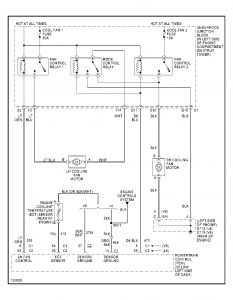You need to start a new question, and PLEASE list the correct engine size and mileage. This thread is a private conversation between the three people involved. When you piggyback on this post, none of the other experts will see your addition or have a chance to reply. That does you a disservice.
As Wrenchtech stated, there is a coolant temperature sensor, never a switch, that tells the Engine Computer what the coolant temperature is. Based on that, the computer turns on one or more relays to run the fan motor. On many models those relays are bypassed and the fan is run directly, (through a different relay), when the AC system is turned on. That is to provide as much cooling as possible, without having to wait for a certain coolant temperature to be reached. The AC system runs in defrost mode too when the heater is being used.
There were some car models that did indeed use a coolant temperature switch for the radiator fan motor. Those were mostly on import cars in the '70s and '80s. Every model I can think of since the late '80s uses a temperature sensor, and the Engine Computer is programmed to turn the fan on at a preset temperature. That is commonly 210 degrees on Chrysler products, and it turns off at 198 degrees. Many GM computers don't turn the fan on until as high as over 225 degrees. While that "input" sensor system is pretty universal, there are many variations of output circuits. They can include a single relay for simple on or off, two relays for high or low speed, and a computer module to run the motor with "pulse-width modulation". PWM provides for continuously-variable speed from fully-off to full high speed. Those are used to reduce fan noise at low speeds
The original diagnostic fault code number was requested, but never listed. It was also stated here, quite accurately, that fault codes never say to replace parts or that one is bad. They only indicate the circuit or system that needs further diagnosis, or the unacceptable operating condition. To add to the misery, temperature sensors have an extremely low failure rate because there is just one component in them. Failures in the circuit are much more commonly caused by corroded or stretched terminals, or cut or grounded wires.
A quick way to test the circuit on many models is to unplug the coolant temperature sensor while the ignition switch is on. That will set a diagnostic fault code, but what you're looking for is the fan should turn on. The Engine Computer won't know coolant temperature, so it turns the fan on as a precaution to insure overheating doesn't occur. If the fan doesn't turn on, it is likely the problem is in the high-current circuit, meaning the relay's contacts, wiring, and fuses. If you have a low-speed relay and a high-speed relay, as Wrenchtech described, it is unlikely both circuits developed a problem at the same time unless a fuse device they have in common has blown. The suspect for that is a tight fan motor. You can identify that by spinning the fan blade by hand. It should coast to a stop after multiple revolutions.
Related to unplugging the sensor, if there's an intermittent connection anywhere in that circuit, the symptom will be the fan motor is running all the time and / or when it's not needed. That is the opposite of not running at all. That means the cause of this problem is not in the sensor circuit. It has to be in the output circuit. Mechanics use a scanner to talk with the Engine Computer and command it to turn on the fan relay(s). That allows us to troubleshoot the circuit without having to wait for the engine to warm up.
One last comment of great value; be aware that all coolant temperature sensors, ambient or intake air temperature sensors, and battery temperature sensors have two wires because their ground circuits are monitored too. If you find a coolant temperature sensor with only a single wire, that is for the dash gauge. Even that has changed now on newer cars. Now, the instrument clusters get their information from the other computers, not from their own sensors.
Friday, February 17th, 2017 AT 5:36 PM


